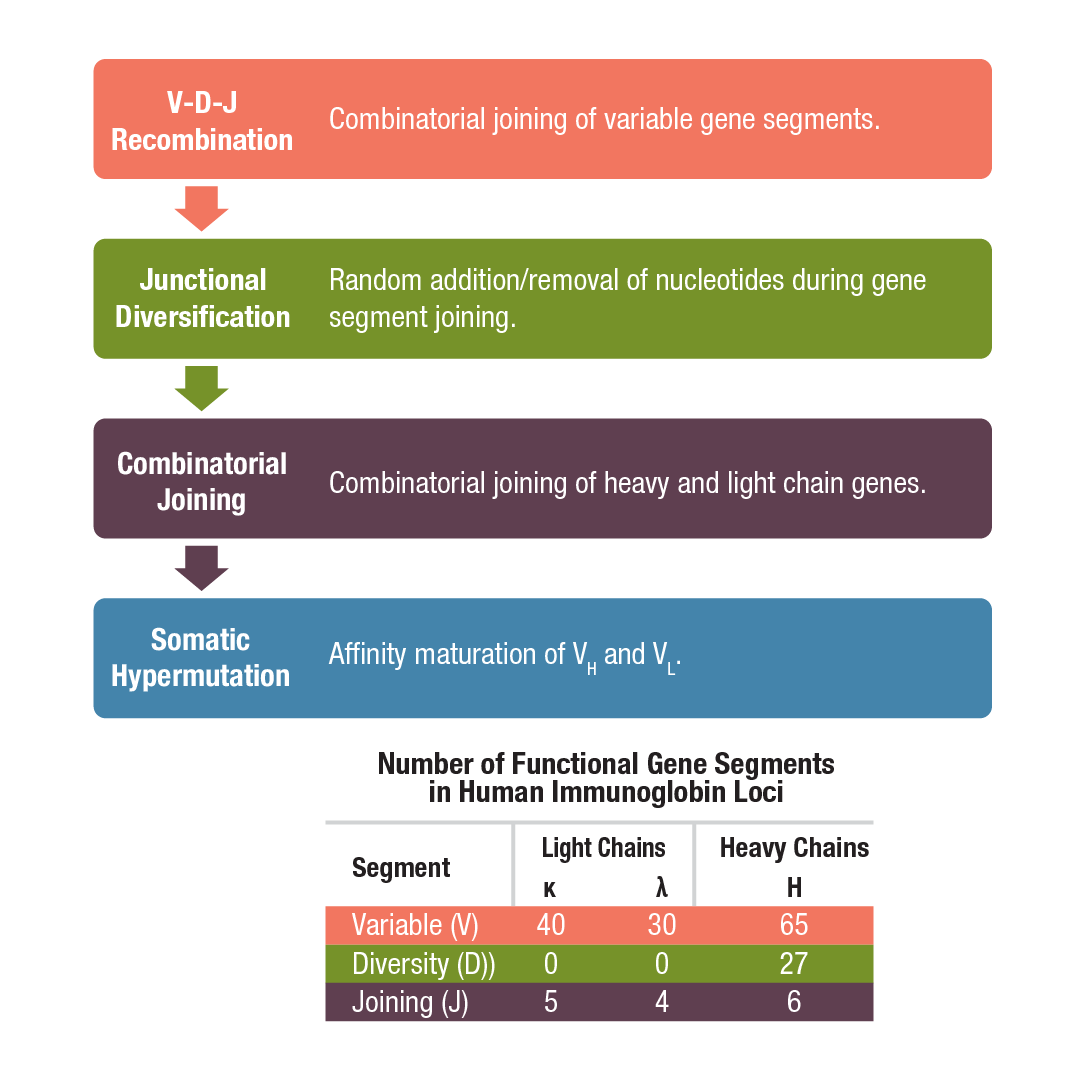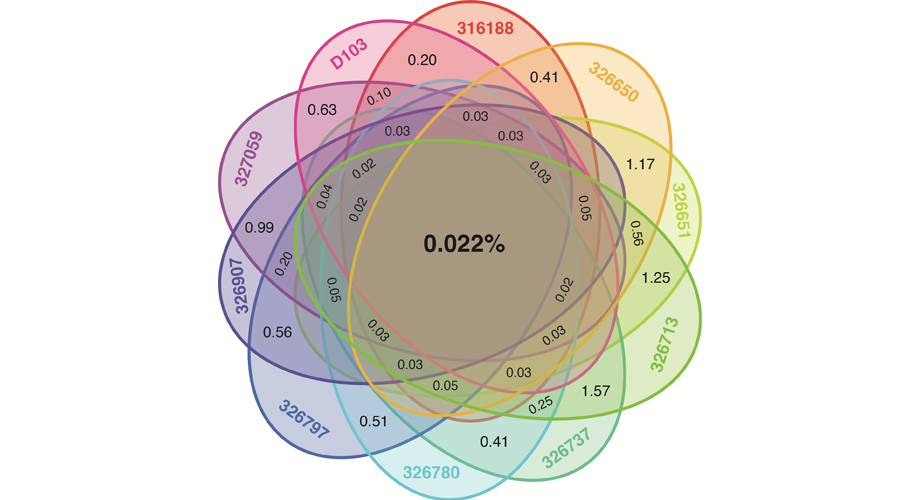The Diversity of Antibodies Billion Different Ones Is Explained by
Antibodies or immunoglobulinsIg are of five different isotypes. Some of the factors that contributed to the diversity of antibodies are pseudogenes gene conversion N-region diversity and the different pairing of light and heavy chains and signal sequence replacement.

Antibody Essentials Part 2 Antibody Diversity And Classification
Immunoglobin A IgA is found in mucosal tissue and is the front line defense against infection.

. The different types of antibodies are. One enzyme to rule them all. How can an animal make more antibodies than there are genes in its genome.
Now the structural basis of antibody specificity is well defined. In a pioneering study published in 1976 Tonegawa could through a series. The body has five different types of antibodies also known as immunoglobulins.
Understanding the process of antibody diversity is quite difficult as it is the most complicated subject in genetics yet it is interesting. Each lymphocyte produces its own specific receptor which is. Genome posses a relatively small number of antibody genes and diversity is generated by mutation and recombination of these genes during somatic development.
Diversity in immunological receptors created during the imprecise process of joining V D and J segments during V DJ recombination. 00043009 And in a phenomenon referred to as immunological memory or recall response the secondary exposure. The human genome for example contains fewer than 50000 genes This problem is not quite as formidable as it might first appear.
It has been estimated that humans generate about 10 billion different antibodies each capable of binding a distinct epitope of an antigen. Antibody diversity therefore poses a special genetic problem. Antibody diversity has a.
Antibody diversity is generated in four main ways. Less antibody diversity The researchers were able to characterize with high accuracy all the antibodies that killifish produce. This remarkable ability results from the trillions of different antigen receptors that are produced by the B and T lymphocytes.
00044400 that kick in and its the combined action again of these antibodies and T cells. The biological origin of antibody diversity. IgM is the first antibody produced in response to a microbial attack by B cells.
An interdisciplinary subject of biology studies immunity and related things is known as immunology. Two of these are consequences of the recombination process just discussed see Sections 4-4 and 4-5 which creates complete immunoglobulin V-region exons during early B-cell development. Amino acid sequences and recently three-dimensional structures of various immunoglobul.
00043613 rapidly leads to massive induction of both antibody titers we have memory killer T cells. Varied receptors or antigen-binding sites are produced by different antibody coding gene segments. Models to Explain Antibody Diversity 1 The Germ Line Theory.
Immunology Quiz- Antibody Diversity. IgA binds to pathogens to tag them for destruction from other antibodies. One enzyme to rule them all Nat Med.
The team grouped the antibodies into clonotypes based on the similarities of the genes that make up the heavy chain. Question 19 1 point The diversity of antibodies 10 billion different ones is explained by alternative splicing RNA editing U thousands of genes for antibodies ODNA editing the removal of all but one copy of each gene segment V D J C. Joining of segments during V DJ recombination is purposefully sloppy.
Models to Explain Antibody Diversity 1 The Germ Line Theory. Several complex genetic mechanisms have evolved that. The structure of the antibodies is determined by genes but as the human genome only contains about 100 000 genes it seemed unreasonable that they could allow the production of maybe a billion different antibodies.
Genome posses the large repertoire of antibody genes to account for all the antibody diversity 2 The Somatic Variation Theory. Genome posses a relatively small number of antibody genes and diversity is generated by mutation and recombination of these genes. Antibody diversity has a compelling fascination for many scientists and over the years speculations have sometimes seemed more numerous than facts.
Diversity comes from the fact that there are multiple copies of the V D and J genes that can be joined together in different combinations Figure 2. Two general classes of antigen receptor gene diversification processes in B lymphocytes account for this. Immunoglobulin chains are encoded by_____ that isare rearrangedduring____ development to assemble a functional gene encoding either a heavy or a light chain.
It was also noted that different species could undergo different recombinational events leading to increased or decreased diversity. This classification is on the basis of their H chains. The specific immune system in other words the sum total of all the lymphocytes can recognize virtually any complex molecule that nature or science has devised.
Hundreds of billions of different antibodies are produced to fight off invading pathogens. The diversity of the immunoglobulin repertoire is generated by four main processes. Although a huge repertoire of different antibodies is generated in a single individual the number of genes available to make these proteins is limited by the size of the human genome.
Based on their findings they estimated that the human antibody repertoire is much greater than previously thoughtwith the potential for the body to make a quintillion or one million trillion unique antibodies. Genome posses a large repertoire of antibody genes to account for all the diversity 2 The Somatic Variation Theory. The man who explained this mystery is the Japanese Scientist Susumu Tonegawa.
Each polypeptide chain heavy and light on immunoglobulin has a variable V andconstant C region. Imprecise DNA recombination leads to changes to nucleotide sequences at junction sites and adding diversity to the ABS. Antibodies are proteins and proteins are encoded by genes.
In a majority of mammals each antibody molecule is composed of both a heavy and light chain Figure 1 which each have their own V and J genes to rearrange only the heavy chain has D genes. They found that older killifish have different types of antibodies. Antibody Diversity genetics.
IgA IgD IgG IgE and IgM are different immunoglobulin isotypes. One enzyme to rule them all. A series of DNA-hybridization experiments with various κ-chain mRNAs revealed that there are not enough germline genes to explain.
Authors Michel C Nussenzweig Frederick W Alt. It is the largest antibody and is found in a.

Antibody Definition Structure Types Forms Functions

11 7b Antibody Genes And Diversity Biology Libretexts

Humans May Be Capable Of Producing A Quintillion Different Antibodies Scripps Research

Molecular Basis For Antibody Diversity Only The Case Of Heavy Chain Download Scientific Diagram
No comments for "The Diversity of Antibodies Billion Different Ones Is Explained by"
Post a Comment